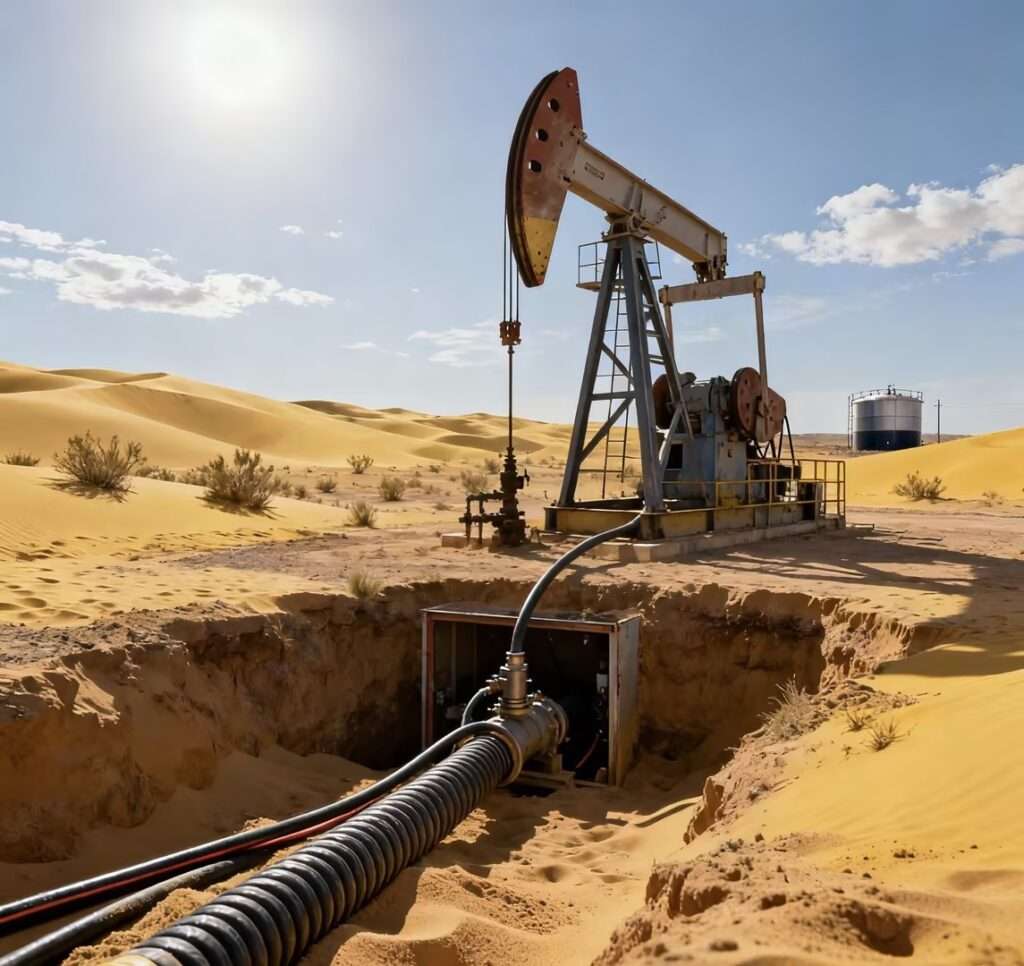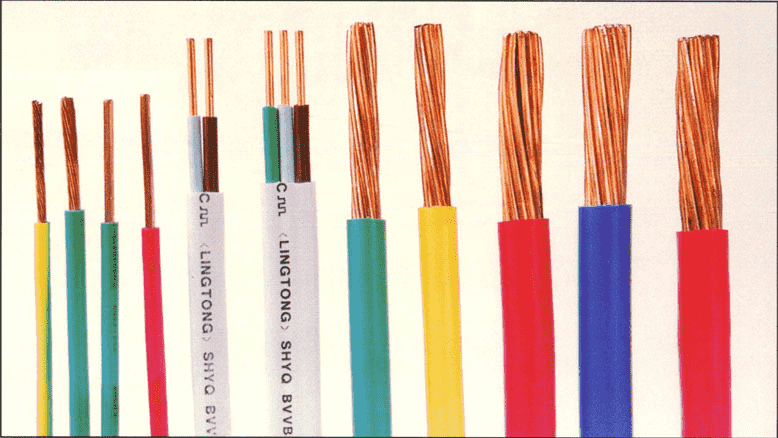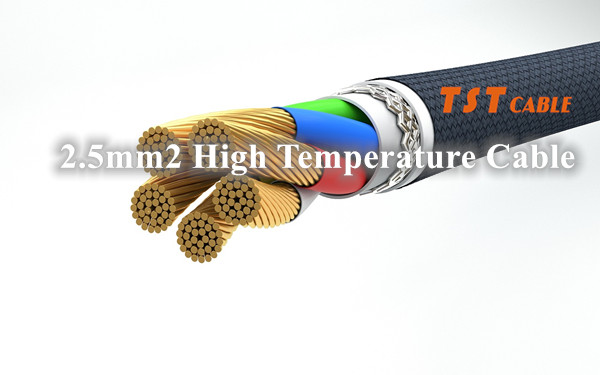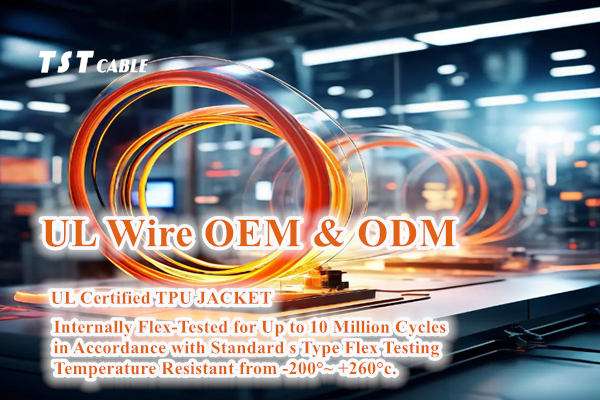In oil wells thousands of meters deep, the high-temperature, high-pressure, and highly corrosive oil and gas environment is like purgatory. The submersible pump power cables, known as the “lifeline of the oil field,” precisely deliver electrical energy to the downhole submersible pumps. They are not only the “energy channel” for oil extraction but also key equipment determining the lifespan and recovery rate of a single well. From onshore deserts to deep-sea oil fields, from traditional rubber insulation to intelligent composite structures, this “invisible artery” is leveraging technological innovation to reshape the global energy landscape.

Specialized Cables Used with Submersible Pump Units
Submersible pump cables are specialized power transmission equipment used with submersible pump units. They are mainly used for power supply in the high-temperature, high-pressure, and highly corrosive environments of oil wells, connecting the surface control cabinet to the downhole unit. Their operating temperature ranges from 80℃ to 260℃, and their rated voltage reaches 3kV-6kV.
I. Extreme Challenges Under Extreme Operating Conditions
Submersible pump cables must operate stably in the following harsh environments:
High Temperature and High Pressure: Deep well temperatures can reach over 180℃, and pressures exceed 30MPa;
Strong Corrosive Media: Containing hydrogen sulfide (H₂S), carbon dioxide (CO₂), and highly salinized formation water;
Mechanical Stress: The cable is subjected to tension, bending, and abrasion due to frequent pump raising and lowering;
No Joints Required: Single cable lengths often exceed 3000 meters, and there must be no joints along the entire length, otherwise, it is prone to breakdown and failure.
Traditional PVC or ordinary rubber cables have a lifespan of only 6–12 months under these conditions, while TST CABLE high-performance submersible pump cables have achieved stable operation for 5–10 years.
II. TST CABLE Core Technology Breakthrough: Three-Layer Armor Protecting Deep-Earth Energy
Modern submersible pump cables employ a four-layer protection system: conductor—insulation—sheath—armor.
1. Conductor: Tin-plated oxygen-free copper for anti-aging
To prevent direct contact between copper and polypropylene, which accelerates aging, the conductor uses tin-plated oxygen-free copper and is coated with an adhesive to ensure a tight bond with the insulation layer, preventing gas infiltration and “air gap discharge.”
2. Insulation Layer: Ethylene propylene diene monomer (EPDM) becomes mainstream
EPDM can operate continuously at temperatures from -40℃ to +180℃, exhibiting excellent corona resistance. Higher-end products use a “polyimide/F46 composite film + EPDM” combination structure, such as the QYYP series launched by Zhongtian Technology. Through a continuous vulcanization process, each layer is firmly bonded, resulting in a partial discharge of <5pC.
3. Barrier Layer: Polytetrafluoroethylene (PTFE) (F40) for Oil and Gas Permeation Prevention
An F40 film is wrapped around the insulation, effectively blocking the intrusion of H₂S and light hydrocarbon gases, extending cable life by more than 30%.
4. Sheath and Armor: Nitrile Rubber + Interlocking Steel Tape
The nitrile rubber sheath is resistant to oil and chemical corrosion, with splined ribs on the surface to enhance friction with the armor; the interlocking steel tape armor overlap rate is >35%, preventing sheath swelling and rupture due to sudden pressure changes during cable operation.
III. Practical Case Studies: From Daqing Oilfield to South China Sea Deepwater
Case 1: Application in Ultra-Deep Wells of Tarim Oilfield, Xinjiang
A well in Xinjiang reaches a depth of 6500 meters, with a bottom-hole temperature of 175℃ and a high concentration of H₂S. Using TST CABLE’s customized high-temperature sulfur-resistant submersible pump cable, it operated without failure for 38 months, doubling the lifespan of traditional cables and increasing crude oil production by 12,000 tons per well. Case 2: Intelligent Upgrade of Bohai Offshore Platforms
CNOOC deployed fiber optic composite submersible pump cables in the Bohai Sea, enabling real-time monitoring of downhole temperature and pressure while transmitting power. After system commissioning, the pump inspection cycle was extended from 18 months to 30 months, and maintenance costs decreased by 40%.
Case 3: Belt and Road Middle East Project
Saudi Aramco oilfields introduced TST CABLE’s flat submersible pump cables, adapted to narrow conduit spaces, and combined with a circular cable switching solution. These cables have operated stably for over 4 years in high-temperature, high-salt environments and have received international customer certification.
IV. Future Trends: Intelligentization, Greening, and Deep-Sea Applications
1. Intelligent Integration: Fiber Optic + Power Integration
TST CABLE fiber optic composite submersible pump cables will become standard equipment, realizing multiple functions of “temperature measurement + power transmission + signal transmission,” supporting the construction of digital oilfields. The global intelligent submersible cable market is expected to exceed US$1.2 billion by 2027.
2. Green Materials: Low-Smoke Halogen-Free, Recyclable Design
In response to environmental policies, the industry is promoting materials such as halogen-free flame-retardant sheaths and bio-based rubber. China’s “Green Manufacturing Standard for Submersible Pump Cables” was piloted in 2024.
3. Deep-Sea and Unconventional Oil and Gas Expansion
With the accelerated development of deep-sea (>1500 meters deep) and shale oil, the demand for ultra-deep well cables with a pressure resistance of 60MPa and a temperature resistance of 200℃ has surged. New technologies such as nano-modified insulation materials and self-healing coatings are being validated in laboratories.
4. Accelerated Domestic Substitution
In the past, the high-end market was monopolized by General Electric Cable (now Prysmian) and Nexans, but now domestic companies such as TST CABLE have captured 70% of the domestic market share and have successfully entered the European, American, Middle Eastern, and African markets.
A seemingly insignificant TST CABLE submersible pump cable connects to the black gold thousands of meters underground, carrying the strategic lifeline of national energy security. From “usable” to “easy to use” and then to “intelligent,” this deeply buried “invisible artery” is injecting surging momentum into global oil and gas exploration with the power of Chinese intelligent manufacturing. As one oilfield engineer put it, “As long as the cable keeps running, the oil will keep flowing—it is a silent hero and the ultimate gatekeeper of deep-earth energy.”
Also available in:
English





